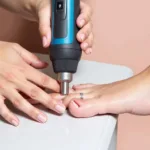Foot care is crucial for overall health, and maintaining the sterility of your tools is paramount. Proper foot care tools sterilization prevents the spread of infections and ensures the safety and well-being of both clients and practitioners. This comprehensive guide explores the importance of sterilizing foot care tools and provides practical advice for implementing effective sterilization techniques.
Ensuring your foot care instruments are correctly sterilized is essential to prevent bacterial, fungal, and viral infections. We’ll cover various sterilization methods, best practices, and answer frequently asked questions to give you a complete understanding of foot care tool sterilization. Neglecting proper sterilization can lead to severe health complications, so let’s dive in and learn how to maintain a safe and hygienic environment for all your foot care needs.
Why is Foot Care Tools Sterilization so Important?
Sterilization eliminates all forms of microbial life, including bacteria, viruses, fungi, and spores. This process is critical for foot care tools because they come into direct contact with skin and nails, which can harbor harmful microorganisms. Even small cuts or abrasions can become entry points for infection if tools are not properly sterilized.
Preventing the Spread of Infection
Proper sterilization prevents the transmission of infections from one person to another. This is particularly crucial in salon settings where multiple clients are serviced using the same tools. Common infections that can be spread through contaminated foot care tools include athlete’s foot, onychomycosis (nail fungus), and bacterial infections.
Ensuring Client Safety
Clients trust professionals to provide safe and hygienic services. By sterilizing foot care tools, professionals demonstrate their commitment to client safety and well-being. This builds trust and reinforces the professionalism of the practice.
 Foot Care Tools Sterilization Process
Foot Care Tools Sterilization Process
Maintaining Professional Standards
Sterilizing foot care tools is a fundamental aspect of maintaining professional standards in the industry. Adherence to sterilization protocols ensures compliance with health and safety regulations, which protects both clients and practitioners.
Different Methods for Sterilizing Foot Care Tools
There are several effective methods for sterilizing foot care tools, each with its advantages and disadvantages.
Autoclaving
Autoclaving is considered the gold standard for sterilization. This method uses high-pressure steam to kill all microorganisms, including resistant spores. Autoclaves are highly effective but require specialized equipment and training.
Dry Heat Sterilization
Dry heat sterilization uses high temperatures for an extended period to eliminate microorganisms. This method is suitable for tools that cannot withstand the moisture of steam sterilization.
Chemical Sterilization
Chemical sterilants, such as glutaraldehyde and ethylene oxide, can be used to sterilize foot care tools. However, these chemicals can be hazardous and require careful handling and disposal.
Professional nail care tools for ingrown toe are essential for addressing specific foot conditions and require careful sterilization to maintain their effectiveness and prevent infection.
UV Sterilization
While UV light can kill some bacteria and viruses, it is not considered a reliable method for complete sterilization, especially for resistant spores. UV sterilization is more effective for sanitization rather than complete sterilization.
Best Practices for Foot Care Tools Sterilization
Regardless of the sterilization method used, following best practices is essential to ensure effectiveness.
Cleaning and Disinfection
Before sterilization, tools must be thoroughly cleaned and disinfected to remove visible debris and reduce the microbial load. This pre-cleaning step enhances the effectiveness of the sterilization process.
Proper Packaging
Tools should be packaged appropriately before sterilization to maintain sterility after the process. Using sterilization pouches or wraps prevents contamination during storage.
Monitoring and Validation
Regularly monitoring and validating the sterilization process is crucial to ensure its effectiveness. Using biological indicators and chemical indicators helps verify that the sterilization equipment is functioning correctly.
Disinfecting nail care tools is an important step prior to sterilization and ensures the removal of visible debris and a reduction in microbial load.
How to sanitize nail care tools provides further guidance on maintaining hygiene and preventing the spread of infection.
Conclusion
Foot care tools sterilization is crucial for maintaining hygiene, preventing infections, and ensuring client safety. By implementing proper sterilization techniques and following best practices, professionals can uphold the highest standards of care and provide a safe and healthy environment for everyone. Regularly reviewing and updating sterilization protocols ensures continued effectiveness and compliance with evolving industry standards. Remember, proper foot care tools sterilization is not just a best practice, it’s a necessity.
FAQ
- What is the most effective method for sterilizing foot care tools? Autoclaving is considered the gold standard.
- Can I use UV light to sterilize my foot care tools? UV light is more suitable for sanitization, not sterilization.
- How often should I sterilize my foot care tools? After each use on a client.
- What is the difference between sterilization and disinfection? Sterilization eliminates all microbial life, while disinfection reduces the number of microorganisms.
- Why is pre-cleaning important before sterilization? Pre-cleaning removes debris and enhances the effectiveness of sterilization.
- How do I store sterilized tools? In sterile pouches or wraps to prevent contamination.
- Where can I find more information on foot care tool sterilization guidelines? Contact your local health department or professional organizations.
If you require assistance or have questions regarding car diagnostics, don’t hesitate to contact us via WhatsApp: +1(641)206-8880, Email: [email protected], or visit us at 910 Cedar Lane, Chicago, IL 60605, USA. We have a 24/7 customer service team ready to assist you.
